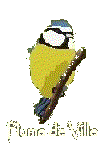Plume de Ville
From day to day.
September 2009
September 3th
A map for
back-to-school.
Map Butterfly
[Levan-Araschnia Nymphalidae Nymphalinae-]
(Carte géographique).
It has been a long time since I wanted to see one.
And in the last days of August, I came across several ones, even in Paris.
This one has very obligingly posed, opening and closing the wings, turning to
show its best profile.
(30-35mm)
He donned here its black
summer dress.
Two generations per year for this butterfly. This is the 2nd generation. (Form
prorsa or summer)
The butterflies hatched in the spring have a completely different orange dress.
I hope to show you this first generation one of next springs. (Form levana or
spring.)
The livery of the butterfly depends on the conditions suffered by the pupae.
These are the conditions of temperature and the length of day and night to
determine these variations.
The underside is similar for two generations, but more or less white.
Another
lover of nettles ... with four legs.
Only the last two pairs of legs allow him to walk, the first pair is atrophied
in his nymphalidae family.
http://www.leps.it/indexjs.htm?SpeciesPages/ArascLevan.htm
http://insectes-net.fr/araschnia/araschnia2.htm
September 6th
Green
leafhopper.
[Viridis-leafhopper Homoptera Cicadellide -] (cicadelle verte)
Beautiful soft green for this female who jumps off as soon as you approach too
closely.
It is small, less than 10 mm.
They become
more numerous in late August and September.
Beautiful,
but they are dreaded sap-sucking pests.
It frequents meadows, woods and moist places.
In large groups they quickly weaken plants.
Males have bluish
wings.
The underside of the abdomen is striped yellow and black
When they
are frightened leafhoppers jump like springs on all directions.
But I wonder if this is not in a haphazard way.
Some have jumped directly to water. Whenever one of them lands on the water,
this small red-eyed damselfly body, lying nearby, as they used to stand, fell
over it. Only to go back, disappointed, leafhoppers are not edible?
Silver Y
moth.
[Autographa gamma-Plusiinae Noctuidae]
(Le Gamma ou Lambda ou Plusie gamma)
I disturbed it watering my plants.
It flew and it was very hard to find. It knows how to merge with its
environment and its support.
050809
It is a migratory
butterfly, of the moth's family. Moth but is also active by day. He was named
Lambda Gamma or referring to its two silvery white spots. It goes to the North
where it will lay eggs (several generations) and then back to south in autumn.
Here it is busy foraging lavender.
Ph. 280709
September 9th
Always faithful to its
territory, the robin is there indeed. It sings this September morning in little
short and loud sentences. Two other ones, positioned in trees and bushes around
him, return its "This is my territory"
From time to time some longer and gentle chirping.
Ready to
dive and hide under cover at the slightest alarm, the little Dunnock [Prunella
modularis].
Dressed as a sparrow, he pecks looking for a good bite on the ground but
remains cautious on the edge of the thicket. It raises the dead leaves and
twigs and explores its territory at its calm pace, legs well bent.
So discreet that it disappears from sight as soon as it enters a bush and then
it is very difficult to find and make out. I kept the same discretion by
staying far enough away from it and it spent a long time walking his path.
Tsit, tsitr, tsitr...
Here is
one, then two, then three, then a good number, it goes quickly, counting is difficult
...
That day in September, they are more than thirty to start their little cry in
rapid, acute phrases.
Everyone in the same tree, each looking very busy in the leaves. Then one left
the tree and will explore the next and the next instant a second joined it and
suddenly all the flight follows, one after another and landed in the new
target. We see them pass, one, then two, then three, then ...
In the small band of Long-tailed Tits [Aegithalos caudatus] everybody talks at
once and continuously.
They are particularly interested in the horse-chestnuts or conker trees (Aesculus hippocastanum).
Each of the little chickadee band quickly inspects each piece on all sides.
Suspended by the legs, here it peak the leaves, extract a little something.
Then a soft recovery and passes to the next sheet.
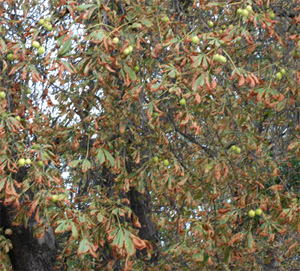 But the
leaves of horse chestnut trees where they are installed have a very long face.
But the
leaves of horse chestnut trees where they are installed have a very long face.
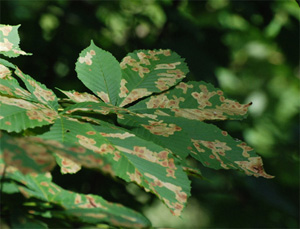
Since June (photo at left was taken at the end of June) the horse chestnuts begin to take this appearance with broad spots, as burned.
Their leaves will shrivel and fall.
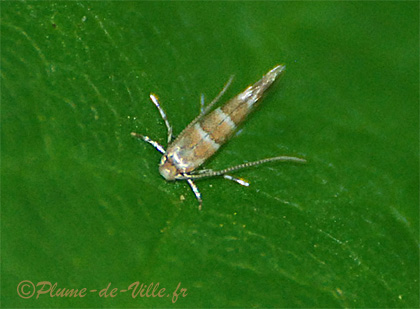
The perpetrators?
Here they are. The trees are attacked by the caterpillars of a small moth, Cameraria ohridella or the horse
chestnut leaf miner. It is 3-5mm long, it is golden beige, striped with white
stripes.
The trees are found in a deplorable state due to its passage.
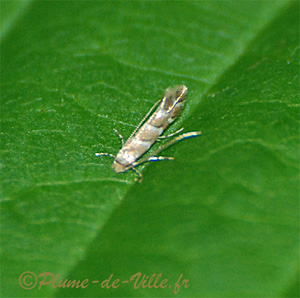
Here are the moths seen in spring when they emerge from their chrysalis (ph. 130509). They are found resting on leaves (still green!).
The female lays eggs on the leaves and once the eggs hatch, the larva enters the leaf from which it feeds internally. The pocket thus created is called "mine". Then the larvae pupate always its mine, in a cocoon. The chrysalis will pierce the wall of the sheet and the moth will emerge.
There are several generations per year. The latest generation of pupae spends the winter in the leaves on the ground.
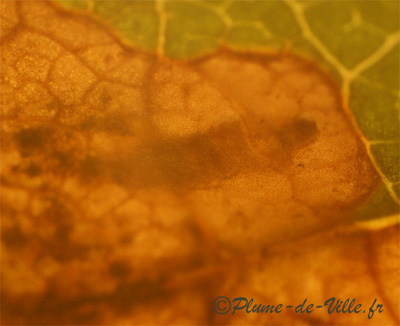
These caterpillars are leaf miners that settle in the leaf and eat the inside. We see one here by transparency in his box.
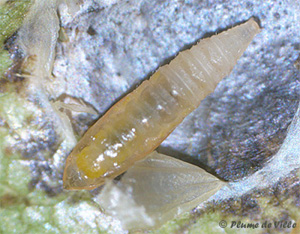
It is very
likely (and so much better!) that our chickadees visit the horse chestnuts to
remove and eat the larvae.
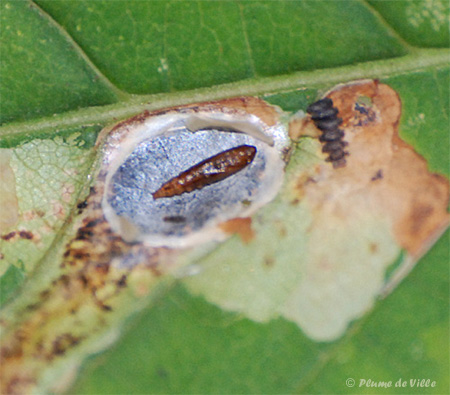
This is the
inside of a leaf after opening a "mine" with the larva occupies it.
(3mm)
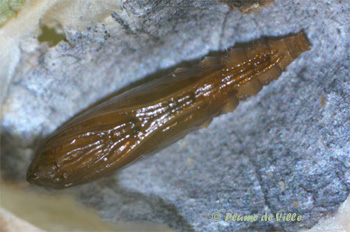
These photos were taken in Paris where Cameraria arrived in 2001. It is still present.
http://www.inra.fr/presse/cameraria_un_nouveau_ravageur_des_marronniers_en_france
http://cameraria.orleans.inra.fr/
http://fr.wikipedia.org/wiki/Mineuse_du_marronnier
September 14th
Again the Hummingbird Hawk-moth but this one was kind enough to be
photographed lengthily.
Always in a geranium which he can safely reach the nectar with its long proboscis,
witch here appears pink dotted with geranium pollen.
It stays
very little time per flower. Once each flower explored, it went away.
21 septembre
Roaring, impressive, all dressed in black, with blue-violet reflections
from the right perspective, here is the carpenter bee Xylocopa or
purple [Xylocopa violacea-Hymenoptera -].
Do not panic! It is absolutely not aggressive and we can contemplate at leisure.
It is one of the largest bees with 20-28 mm and 5 cm wide.
It is a solitary bee that has beautiful "teeth".
One
day several years ago, we were very intrigued by the mounds of sawdust
and wood chips mahogany under a window on a wooden frame. The chips
swept the next day the mound was bigger! Later and a big black bee came and slipped into a substantial hole in
the wood of the window, hole leading to a beautiful gallery.
Our first meeting with the carpenter.
The wood in question was , the excavation was not
really soft or rotten.
She
dug to build galleries divided into boxes for each to receive an egg.
No pictures, the owner of the window did not allow more ...
Here it is in full harvest of pollen to store in its galleries for its larvae.
I had not seen for several years but this year (coincidence?) I've met several in September.
(Paris Sept 2009)
24 septembre
This small insect 8-9 mm to the pretty livery is another leafhopper.
The rhododendron leafhopper [Graphocephala Fennah].
It
feeds on sap by piercing the plant. It is responsible for the
transmission of a disease that causes rhododendron wilt buttons.
(Paris Sept 2009)
It is native to North America and was introduced in 1930 in Europe.
